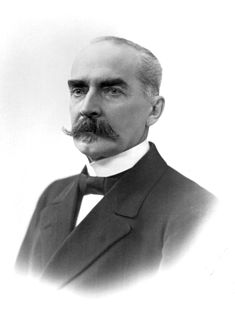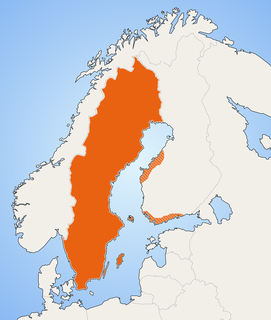
Kaarlo Juho Ståhlberg was a Finnish jurist and academic, who played a central role in the drafting of the Constitution of Finland in 1919. He was the first President of Finland (1919–1925) and a liberal nationalist.

The University of Helsinki is a university located in Helsinki, Finland since 1829, but was founded in the city of Turku in 1640 as the Royal Academy of Åbo, at that time part of the Swedish Empire. It is the oldest and largest university in Finland with the widest range of disciplines available. Around 36,500 students are currently enrolled in the degree programs of the university spread across 11 faculties and 11 research institutes.
The municipalities represent the local level of administration in Finland and act as the fundamental, self-governing administrative units of the country. The entire country is incorporated into municipalities and legally, all municipalities are equal, although certain municipalities are called cities or towns. Municipalities have the right to levy a flat percentual income tax, which is between 16 and 22 percent, and they provide two thirds of public services. Municipalities control many community services, such as schools, health care and the water supply, and local streets. They do not maintain highways, set laws or keep police forces, which are responsibilities of the central government.

Education in Finland is an education system with fully subsidised meals served to full-time students. The present education system in Finland consists of daycare programmes and a one-year "pre-school" ; a nine-year compulsory basic comprehensive school ; post-compulsory secondary general academic and vocational education; higher education ; and adult education. The Finnish strategy for achieving equality and excellence in education has been based on constructing a publicly funded comprehensive school system without selecting, tracking, or streaming students during their common basic education. Part of the strategy has been to spread the school network so that pupils have a school near their homes whenever possible or, if this is not feasible, e.g. in rural areas, to provide free transportation to more widely dispersed schools. Inclusive special education within the classroom and instructional efforts to minimize low achievement are also typical of Nordic educational systems.
The lyceum is a category of educational institution defined within the education system of many countries, mainly in Europe. The definition varies among countries; usually it is a type of secondary school.

The Hanken School of Economics is a business school located in Helsinki and Vaasa. Hanken was established as a community college in 1909 and originally offered a two-year vocational education. It is the only institution of its kind in Finland.

A vocational school, sometimes also called a trade school, career center, or vocational college, is a type of educational institution, which, depending on the country, may refer to secondary or post-secondary education designed to provide vocational education, or technical skills required to perform the tasks of a particular and specific job. In the case of secondary education, these schools differ from academic high schools which usually prepare students who aim to pursue tertiary education, rather than enter directly into the workforce. With regard to post-secondary education, vocational schools are traditionally distinguished from four-year colleges by their focus on job-specific training to students who are typically bound for one of the skilled trades, rather than providing academic training for students pursuing careers in a professional discipline. While many schools have largely adhered to this convention, the purely vocational focus of other trade schools began to shift in the 1990s "toward a broader preparation that develops the academic" as well as technical skills of their students.

The Organising Bureau of European School Student Unions (OBESSU) is the European platform for cooperation between the national school student unions in Europe, active in general secondary and secondary vocational education. All member organisations are independent, national, representative and democratic school student unions. The platform currently unites 31 national school student unions from 24 European countries.

In various European countries, student caps of different types are, or have been, worn either as a marker of a common identity, as is the case in the Nordic countries, or to identify the wearer as a member of a smaller body within the larger group of students, as is the case with the caps worn by members of German Studentenverbindungen.
The Finnish International Baccalaureate Society ry. (FIBS) is a registered Finnish organisation for both IB students and IB graduates. FIBS members are students who are currently undergoing the International Baccalaureate Diploma Programme within Finland. The organisation's purpose is to advance the recognition of the IB in Finnish institutes of higher education and assist and ease the placement of students into universities. FIBS further aims to uphold the student rights for every IB student, current and past and to keep in contact with all IB institutions in Finland and to achieve corporation. It is also a member of the Finnish Upper Secondary School Students' Union (SLL).
The history of formal education in Estonia dates back to the 13–14th centuries when the first monastic and cathedral schools were founded. The first primer in the Estonian language was published in 1575. The oldest university is the University of Tartu which was established by the Swedish king Gustav II Adolf in 1632. In 1919, university courses were first taught in the Estonian language.
The Student Union of the University of Turku is a body to which, under public law, all University of Turku bachelor's and master's degree students belong. It is among the oldest student unions in Finland. Postgraduate and exchange students may become a member of TYY, but it is not obligatory. Visiting are ineligible to join TYY.

Aalto University is a university primarily located in Greater Helsinki, Finland. It was established in 2010 as a merger of three major Finnish universities: the Helsinki University of Technology, the Helsinki School of Economics, and the University of Art and Design Helsinki. The close collaboration between the scientific, business and arts communities is intended to foster multi-disciplinary education and research. The Finnish government, in 2010, set out to create a university that fosters innovation, merging the three institutions into one.
Finnish Student Sports Federation (OLL) is a national organisation advocating, supporting and promoting the interests of students' sports and physical activities. The federation was founded in 1924. The federation's office is in Helsinki.
Arcada University of Applied Sciences is a university of applied sciences in Helsinki, Finland. It is owned and maintained by the Arcada Foundation.














